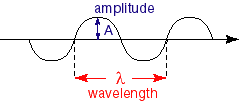What Is A Sound Wave?
A sound wave is produced by a mechanical vibration,
such as a tuning fork.
The vibrating object causes the surrounding medium, such as air, to vibrate as well.
The wave travels through the medium to a detector, like your ear, and it is heard.
As with any type of wave, a sound wave is also described by it's
wavelength, amplitude, period, and frequency.

http://www.school-for-champions.com/science/sound.htm
WAVELENGTH is the distance from one point on the wave,
to the next identical point, or the length of one part of the wave.
AMPLITUDE is the distance from the midpoint to the place of maximum displacement.
FREQUENCY is the number of cycles that occur in one second.
It is also the inverse of the period.
PERIOD is the time it takes for a wave to complete one full cycle.
It is also the inverse of frequency.
LONGITUDINAL WAVE

(http://www.gmi.edu/~drussell/Demos/waves/wavemotion.html)
The vibrating object causes the surrounding medium, such as air, to vibrate as well.
The wave travels through the medium to a detector, like your ear, and it is heard.
As with any type of wave, a sound wave is also described by it's
wavelength, amplitude, period, and frequency.

http://www.school-for-champions.com/science/sound.htm
WAVELENGTH is the distance from one point on the wave,
to the next identical point, or the length of one part of the wave.
AMPLITUDE is the distance from the midpoint to the place of maximum displacement.
FREQUENCY is the number of cycles that occur in one second.
It is also the inverse of the period.
PERIOD is the time it takes for a wave to complete one full cycle.
It is also the inverse of frequency.
Sound waves are longitudinal waves that consist of high and low pressure areas called condensations and rarefactions, respectively. Since sound waves are longitudinal waves, the particles of the medium oscillate parallel to the velocity of the wave. The animation below shows how a sound wave causes air molecules to vibrate back and forth. The individual particles do not travel along the wave. They only oscillate back and forth and the wave still propagates through them.

(http://www.gmi.edu/~drussell/Demos/waves/wavemotion.html)